Cisco Systems 88310756, MICWR0776 Users Manual

Cisco Unified IP Phone 8831 User Guide for Cisco Unified Communications Manager 9.3
First Published: April 15, 2013
Americas Headquarters
Cisco Systems, Inc. 170 West Tasman Drive
San Jose, CA 95134-1706 USA http://www.cisco.com Tel: 408 526-4000
800 553-NETS (6387) Fax: 408 527-0883
THE SPECIFICATIONS AND INFORMATION REGARDING THE PRODUCTS IN THIS MANUAL ARE SUBJECT TO CHANGE WITHOUT NOTICE. ALL STATEMENTS, INFORMATION, AND RECOMMENDATIONS IN THIS MANUAL ARE BELIEVED TO BE ACCURATE BUT ARE PRESENTED WITHOUT WARRANTY OF ANY KIND, EXPRESS OR IMPLIED. USERS MUST TAKE FULL RESPONSIBILITY FOR THEIR APPLICATION OF ANY PRODUCTS.
THE SOFTWARE LICENSE AND LIMITED WARRANTY FOR THE ACCOMPANYING PRODUCT ARE SET FORTH IN THE INFORMATION PACKET THAT SHIPPED WITH THE PRODUCT AND ARE INCORPORATED HEREIN BY THIS REFERENCE. IF YOU ARE UNABLE TO LOCATE THE SOFTWARE LICENSE OR LIMITED WARRANTY, CONTACT YOUR CISCO REPRESENTATIVE FOR A COPY.
The following information is for FCC compliance of Class A devices: This equipment has been tested and found to comply with the limits for a Class A digital device, pursuant to part 15 of the FCC rules. These limits are designed to provide reasonable protection against harmful interference when the equipment is operated in a commercial environment. This equipment generates, uses, and can radiate radio-frequency energy and, if not installed and used in accordance with the instruction manual, may cause harmful interference to radio communications. Operation of this equipment in a residential area is likely to cause harmful interference, in which case users will be required to correct the interference at their own expense.
The following information is for FCC compliance of Class B devices: This equipment has been tested and found to comply with the limits for a Class B digital device, pursuant to part 15 of the FCC rules. These limits are designed to provide reasonable protection against harmful interference in a residential installation. This equipment generates, uses and can radiate radio frequency energy and, if not installed and used in accordance with the instructions, may cause harmful interference to radio communications. However, there is no guarantee that interference will not occur in a particular installation. If the equipment causes interference to radio or television reception, which can be determined by turning the equipment off and on, users are encouraged to try to correct the interference by using one or more of the following measures:
•
•
•
•
Reorient or relocate the receiving antenna.
Increase the separation between the equipment and receiver.
Connect the equipment into an outlet on a circuit different from that to which the receiver is connected.
Consult the dealer or an experienced radio/TV technician for help.
Modifications to this product not authorized by Cisco could void the FCC approval and negate your authority to operate the product
The Cisco implementation of TCP header compression is an adaptation of a program developed by the University of California, Berkeley (UCB) as part of UCB’s public domain version of the UNIX operating system. All rights reserved. Copyright © 1981, Regents of the University of California.
NOTWITHSTANDING ANY OTHER WARRANTY HEREIN, ALL DOCUMENT FILES AND SOFTWARE OF THESE SUPPLIERS ARE PROVIDED "AS IS" WITH ALL FAULTS. CISCO AND THE ABOVE-NAMED SUPPLIERS DISCLAIM ALL WARRANTIES, EXPRESSED OR IMPLIED, INCLUDING, WITHOUT LIMITATION, THOSE OF MERCHANTABILITY, FITNESS FOR A PARTICULAR PURPOSE AND NONINFRINGEMENT OR ARISING FROM A COURSE OF DEALING, USAGE, OR TRADE PRACTICE.
IN NO EVENT SHALL CISCO OR ITS SUPPLIERS BE LIABLE FOR ANY INDIRECT, SPECIAL, CONSEQUENTIAL, OR INCIDENTAL DAMAGES, INCLUDING, WITHOUT LIMITATION, LOST PROFITS OR LOSS OR DAMAGE TO DATA ARISING OUT OF THE USE OR INABILITY TO USE THIS MANUAL, EVEN IF CISCO OR ITS SUPPLIERS HAVE BEEN ADVISED OF THE POSSIBILITY OF SUCH DAMAGES.
Any Internet Protocol (IP) addresses used in this document are not intended to be actual addresses. Any examples, command display output, and figures included in the document are shown for illustrative purposes only. Any use of actual IP addresses in illustrative content is unintentional and coincidental.
Cisco and the Cisco logo are trademarks or registered trademarks of Cisco and/or its affiliates in the U.S. and other countries. To view a list of Cisco trademarks, go to this URL: http:// www.cisco.com/go/trademarks. Third-party trademarks mentioned are the property of their respective owners. The use of the word partner does not imply a partnership relationship between Cisco and any other company. (1110R)
© 2013 Cisco Systems, Inc. All rights reserved.

C O N T E N T S
C H A P T E R |
1 |
Preface 1 |
|
|
|
|
|
|
Introduction 1 |
|
|
|
|
|
|
Additional Information |
2 |
|
||
|
|
Safety and Performance Information |
2 |
|||
|
|
Power outage 2 |
|
|
|
|
|
|
External devices |
2 |
|
|
|
|
|
Cisco product security overview |
3 |
|||
|
|
Accessibility Features 3 |
|
|||
|
|
Features of your Cisco Unified IP Phone |
5 |
|||
C H A P T E R |
2 |
|||||
|
|
Buttons and hardware 5 |
|
|||
|
|
Display Control Unit |
6 |
|
||
|
|
Sound Base 7 |
|
|
|
|
|
|
Wireless extension microphone and charger 9 |
||||
|
|
Wired extension microphone kit 11 |
||||
|
|
Phone screen 12 |
|
|
|
|
|
|
Phone screen cleaning 14 |
|
|||
|
|
Phone connections |
14 |
|
|
|
|
|
Install ferrite bead 16 |
|
|||
|
|
Remove ferrite bead 17 |
|
|||
|
|
General IP Phone information 17 |
|
|||
|
|
Power-saving mode |
17 |
|
||
|
|
Feature availability |
18 |
|
|
|
|
|
Applications |
19 |
|
|
|
C H A P T E R |
3 |
|
|
|
||
|
|
Services |
19 |
|
|
|
|
|
Access Services |
19 |
|
|
|
|
|
Call History 19 |
|
|
|
|
Cisco Unified IP Phone 8831 User Guide for Cisco Unified Communications Manager 9.3
iii

Contents
View call history 20
View call record details 20
Dial from Call History 21
Edit phone number 21
Clear call history 21
Delete call record 22
Preferences 22
Ringtones 22
Change Ringtone 22
Contrast 23
Adjust Contrast 23
Linked Mode 23
Link IP Phones 24
IP Phone Information 24
Administrator Settings 25
C H A P T E R 4
Contacts 27
Corporate Directory 27
Dial Contact from Search 27
Dial Contact from Search during an active call 28
Personal Directory 28
Personal Directory options 29
Sign In and Out of Personal Directory 29
Add Personal Directory entry 30
Search for entry in Personal Directory 30
Dial number from Personal Directory 31
Delete Personal Directory entry 31
Edit Personal Directory entry 31
Fast Dial codes with Personal Directory 32
Assign fast dial code to PAB from the phone 32
Assign fast dial code to PAB from User Options web page 32
Place call using fast dial code 33
Delete fast dial code 33
C H A P T E R 5
Messages 35
Cisco Unified IP Phone 8831 User Guide for Cisco Unified Communications Manager 9.3
iv

Contents
Personalize voicemail 35
Voice message identification 35
Access voice messages 35
C H A P T E R 6 |
Calling Features |
37 |
|
|
|
|
Softkey feature map 38 |
|
|
|
|
|
Survivable Remote Site Telephony overview 39 |
||||
|
Answer 41 |
|
|
|
|
|
Call Back 42 |
|
|
|
|
|
Set Up Call Back notification |
42 |
|
||
|
Call Forward 42 |
|
|
|
|
|
Forward calls 43 |
|
|
|
|
|
Call Park 43 |
|
|
|
|
|
Park call |
43 |
|
|
|
|
Call Pickup |
44 |
|
|
|
|
Answer call using Pickup 44 |
|
|
||
|
Answer call using Group Pickup and Group Pickup Number 44 |
||||
|
Answer call using Group Pickup and phone number 45 |
||||
|
Answer call using Other Pickup |
45 |
|||
|
cBarge 45 |
|
|
|
|
|
Join conference on shared line |
45 |
|||
|
Conference |
45 |
|
|
|
|
Add third party to conference |
46 |
|
||
|
View conference participants |
46 |
|
||
|
Remove conference participants |
46 |
|||
|
Divert 47 |
|
|
|
|
|
Divert call 47 |
|
|
|
|
|
Do Not Disturb 47 |
|
|
|
|
|
Turn DND on and off 47 |
|
|
|
|
|
Enhanced Room Coverage 48 |
|
|
|
|
|
Wireless Microphone menu |
49 |
|
||
|
Pair wireless microphone 49 |
|
|
||
|
Unpair wireless microphone |
50 |
|
||
|
Extension Mobility 51 |
|
|
|
|
|
Enable Extension Mobility |
51 |
|
|
|
Cisco Unified IP Phone 8831 User Guide for Cisco Unified Communications Manager 9.3
v

Contents
Fast Dial 51
Place call using Fast Dial 52
Hold 52
Hold active call 52
Switch between active and multiple holding calls 53
Hold active call and answer new incoming call 53
Hold Reversion 53
Respond to Hold Reversion notification 53
Meet Me Conference 54
Host Meet Me Conference 54
Join Meet Me Conference 54
Mobile Connect 54
Enable Mobile Connect 55
Switch IP phone call to mobile phone 55
Switch mobile call to IP phone 56
Monitoring and Recording 56
Multiple calls per line 56
Multiple incoming calls 56
Call ended on line with multiple calls 56
Outbound call maximum 56
Answer second call on same line 57
Switch between calls on same line 57
Create conference with two calls on same line 57
Transfer two calls on same line 57
Shared Line 58
Mute 58
Mute IP phone sound base 59
Mute IP phone DCU 59
On-Hook dialing 59
Dial number on-hook 59
Plus Dialing 59
Dial international number 60
Privacy 60
Enable privacy on shared line 60
Quality Reporting Tool 61
Cisco Unified IP Phone 8831 User Guide for Cisco Unified Communications Manager 9.3
vi

Contents
C H A P T E R 7
Report IP phone problems 61
Redial 61
Redial number 61
Shared lines 61
Speed Dial 62
Place call using speed dial codes 62
Transfer 62
Transfer call to another number 62
WebDialer 63
Use WebDialer with Cisco directory 63
Use WebDialer with another online corporate directory 63
Change WebDialer preferences 64
User Options web pages 65
Sign in and out of User Options web pages 65
Select device from User Options web page 66
Features and services setup on Web 66
Personal directory on Web 66
Personal Address Book on Web 66
Add new Personal Address Book entry 67
Search Personal Address Book entry 67
Edit Personal Address Book entry 67
Delete Personal Address Book entry 67
Fast Dials on Web 68
Assign Fast Dial code to Personal Directory entry 68
Assign Fast Dial code to phone number 68
Search for Fast Dial entry 69
Edit Fast Dial phone number 69
Delete Fast Dial Personal Address Book entry 69
Address book synchronization tool 69
Speed Dial setup on Web 70
Set up speed dial codes 70
Set up Abbreviated Dialing codes 70
Phone services setup on Web 71
Subscribe to service 71
Cisco Unified IP Phone 8831 User Guide for Cisco Unified Communications Manager 9.3
vii

Contents
C H A P T E R 8
C H A P T E R 9
C H A P T E R 1 0
Search for services 71 |
|
Change or end services 72 |
|
Change service name 72 |
|
Access service on phone 72 |
|
User settings on Web 72 |
|
Change browser password 73 |
|
Change PIN 73 |
|
Change user options web page language setting |
73 |
Change phone display language 74 |
|
Line settings on Web 74 |
|
Set up Call Forward per line 74 |
|
Change voice message indicator setting per line |
75 |
Change audible voice message indicator setting per line 75
Change ring type 75
Update line text label displayed on called party phone 76
Cisco WebDialer 76
Use WebDialer with User Options directory 76
Use WebDialer with another online corporate directory (not User Options directory) 77
Log out of WebDialer 77
Set up, view, or change WebDialer preferences 77
Additional options 79
Troubleshooting 81
General troubleshooting 81
Phone administration data 82
Quality Reporting Tool 83
Cisco one-year limited hardware warranty terms 85
View Cisco information packet 85
Cisco one-year limited hardware warranty terms 86
Cisco Unified IP Phone 8831 User Guide for Cisco Unified Communications Manager 9.3
viii

C H A P T E R 1
Preface
Cisco Unified IP Phone 8831 User Guide describes how to install and use your Cisco Unified IP Phone 8831.
• Introduction, page 1
• Additional Information, page 2
• Safety and Performance Information, page 2
• Accessibility Features, page 3
Introduction
This guide provides you with an overview of the features available on your Cisco Unified IP Phone 8831. You can read it completely for a solid understanding of the capabilities of your phone or refer to the table below for pointers to commonly used sections.
 If you want to...
If you want to...
Review safety information
Connect the phone
Use the phone after it is installed
 Then...
Then...
See Safety and Performance Information, on page 2.
See Phone connections, on page 14.
Start with Features of your Cisco Unified IP Phone, on page 5.
Learn what the phone buttons mean |
See Buttons and hardware, on page 5. |
Learn about the display screen |
See Phone screen, on page 12. |
Make calls |
See Calling Features, on page 37. |
Put calls on hold |
See Hold, on page 52. |
Mute calls |
See Mute, on page 58. |
Cisco Unified IP Phone 8831 User Guide for Cisco Unified Communications Manager 9.3
1

Preface
Additional Information
If you want to... |
Then... |
|
Transfer calls |
See Transfer, on page 62. |
|
Make conference calls |
See Conference, |
on page 45. |
Set up speed dialing |
See Speed Dial, |
on page 62. |
Share a phone number |
See Shared lines, on page 61. |
|
Change the ring volume or type |
See Ringtones, on page 22. |
|
View your missed calls |
See Call History, |
on page 19. |
Listen to your voice messages |
See Messages, on page 35. |
|
Additional Information
You can access the most current Cisco documentation at this URL:
http://www.cisco.com/ipphones/8800
You can access the Cisco website at this URL:
http://www.cisco.com/
You can access the most current licensing information at this URL:
http://www.cisco.com/en/US/docs/voice_ip_comm/cuipph/all_models/openssl_license/8800_ssllic.html
Safety and Performance Information
The following sections provide information about the impact of power outages and external devices on your Cisco Unified IP Phone.
Power outage
Your access to emergency service through the phone depends on the phone being powered. If there is a power interruption, Service and Emergency Calling Service dialing will not function until power is restored. In case of a power failure or disruption, you may need to reset or reconfigure the equipment before using the Service or Emergency Calling Service dialing.
External devices
Cisco recommends using good quality external devices such as headsets, cables, and connectors that are shielded against unwanted radio frequency (RF) and audio frequency (AF) signals.
Cisco Unified IP Phone 8831 User Guide for Cisco Unified Communications Manager 9.3
2

Preface
Cisco product security overview
Note Not all Cisco IP Telephony products support external devices, cords or cables. For more information, consult the documentation for your phone.
Depending on the quality of these devices and their proximity to other devices such as mobile phones or two-way radios, some audio noise may still occur. In these cases, Cisco recommends that you take one or more of these actions:
•Move the external device away from the source of the RF or AF signals.
•Route the external device cables away from the source of the RF or AF signals.
•Use shielded cables for the external device, or use cables with a better shield and connector.
•Shorten the length of the external device cable.
•Apply ferrites or other such devices on the cables for the external device.
Cisco cannot guarantee the performance of external devices, cables, and connectors.
Caution In European Union countries, use only external speakers, microphones, and headsets that are fully compliant with the EMC Directive [89/336/EC].
Cisco product security overview
This product contains cryptographic features and is subject to United States and local country laws governing import, export, transfer, and use. Delivery of Cisco cryptographic products does not imply third-party authority to import, export, distribute, or use encryption. Importers, exporters, distributors, and users are responsible for compliance with U.S. and local country laws. By using this product you agree to comply with applicable laws and regulations. If you are unable to comply with U.S. and local laws, return this product immediately.
Further information regarding U.S. export regulations may be found at http://www.access.gpo.gov/bis/ear/ ear_data.html.
Accessibility Features
The Cisco Unified IP Phone 8800 Series provides accessibility features for the vision impaired, the blind, and the hearing and mobility impaired.
For detailed information about the features on these phones, see http://www.cisco.com/en/US/docs/ voice_ip_comm/cuipph/all_models/accessibility/english/user/guide/access_70.html.
You can also find more information about accessibility at this Cisco website:
http://www.cisco.com/web/about/responsibility/accessibility/index.html
Cisco Unified IP Phone 8831 User Guide for Cisco Unified Communications Manager 9.3
3

Preface
Accessibility Features
Cisco Unified IP Phone 8831 User Guide for Cisco Unified Communications Manager 9.3
4

C H A P T E R 2
Features of your Cisco Unified IP Phone
The Cisco Unified IP Phone 8831 is a full-featured single line conference station that provides voice communication over an IP network. It functions much like a digital business phone, allowing you to place and receive calls and to access features such as mute, hold, transfer, speed dial, call forward, and more. In addition, because conference stations connect to your data network, they offer enhanced IP telephony features, including access to network information and services, and customizable features and services.
The conference station provides a backlit LCD screen, support for up to ten speed-dial numbers, and a variety of other sophisticated functions. Optional microphone extension kits provide enhanced room coverage that can be further expanded by linking two units together.
In addition to basic call-handling features, your conference station can provide enhanced productivity features that extend your call-handling capabilities. Depending on configuration, the conference station supports:
•Access to network data, XML applications, and web-based services.
•Online customizing of conference station features and services from your User Options web pages.
• |
Buttons and hardware, page 5 |
|
• |
Phone screen, page 12 |
|
• |
Phone connections, page |
14 |
• |
General IP Phone information, page 17 |
|
• |
Feature availability, page |
18 |
Buttons and hardware
The Conference Station has two primary components:
•Display Control Unit (DCU)
•Sound Base
In addition, the following optional extension kits can be added to or used with the conference station:
•Wired Microphone Extension Kit
•Wireless Microphone Extension Kit and Charger
Cisco Unified IP Phone 8831 User Guide for Cisco Unified Communications Manager 9.3
5
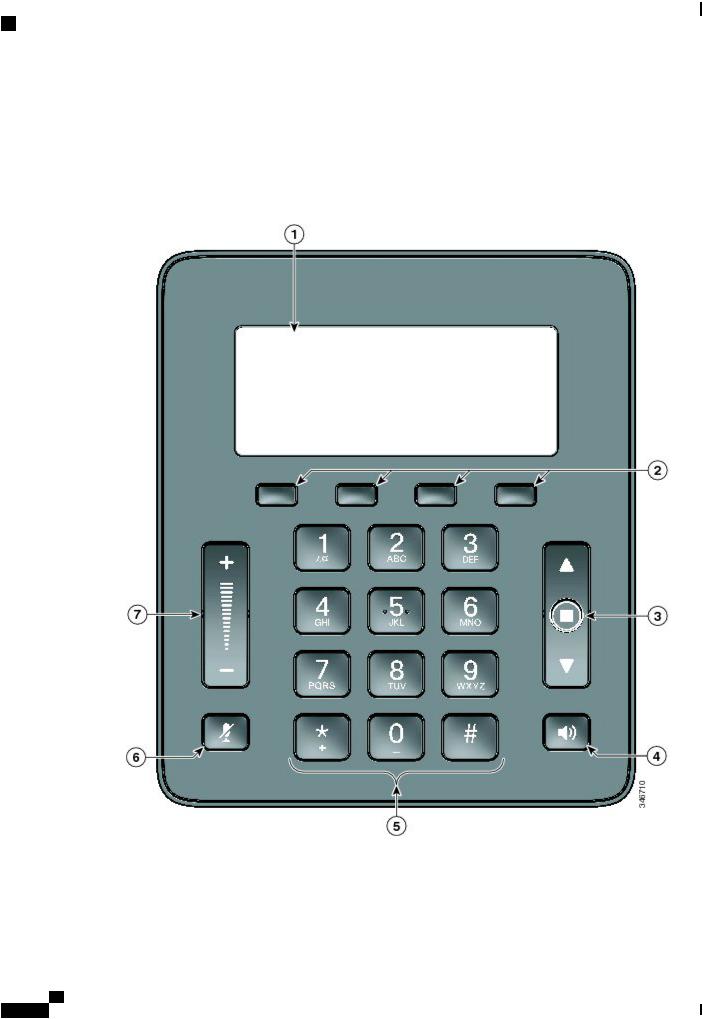
Features of your Cisco Unified IP Phone
Display Control Unit
For your conference station to work, it must be connected to the corporate IP telephony network.
Display Control Unit
The Display Control Unit (DCU) is tethered to the Sound Base via a micro USB connector.
You can use the graphic and table below to identify buttons and hardware on the DCU.
Cisco Unified IP Phone 8831 User Guide for Cisco Unified Communications Manager 9.3
6

Features of your Cisco Unified IP Phone
Sound Base
Table 1: Display Control Unit buttons and softkeys
|
Item |
Description |
1 |
Phone screen |
LCD screen that displays conference station menus and features. |
2 |
Softkeys |
Four programmable keys. |
3 |
Navigator with Select |
2-way navigation bar and Select key that allows you scroll menus |
|
key |
and select items on the display. |
4 |
Call button |
LED backlit call button. |
|
|
Press this key to: |
|
|
• Go Off Hook |
|
|
• Answer an incoming call |
|
|
• Obtain a dial tone to initiate a call |
|
|
• Resume a call |
|
|
• Release a call |
5 |
Keypad |
Allows you to dial phone numbers and enter letters. |
6 |
Mute button |
Toggles the Mute feature. A red back light indicates a call is on |
|
|
mute. |
7 |
Volume rocker |
2-way rocker switch that raises the volume of the speaker. |
Note For details on DCU LED behavior, see LED state definitions.
Sound Base
The Sound Base provides 360 degree audio coverage via four built-in microphones and supports a full duplex speaker phone.
To provide enhanced room coverage, two sound base units can be linked together.
You can use the graphic and table below to identify buttons and connections on the Sound Base.
Cisco Unified IP Phone 8831 User Guide for Cisco Unified Communications Manager 9.3
7

Features of your Cisco Unified IP Phone
Sound Base
Table 2: Sound Base buttons |
|
|
|
Item |
Description |
1, 2, 3 |
LED indicators |
Three LED indicators provide call status information. For |
|
|
details on LED behaviour, see LED state definitions. |
4 |
Mute button |
Backlit mute button. |
Cisco Unified IP Phone 8831 User Guide for Cisco Unified Communications Manager 9.3
8
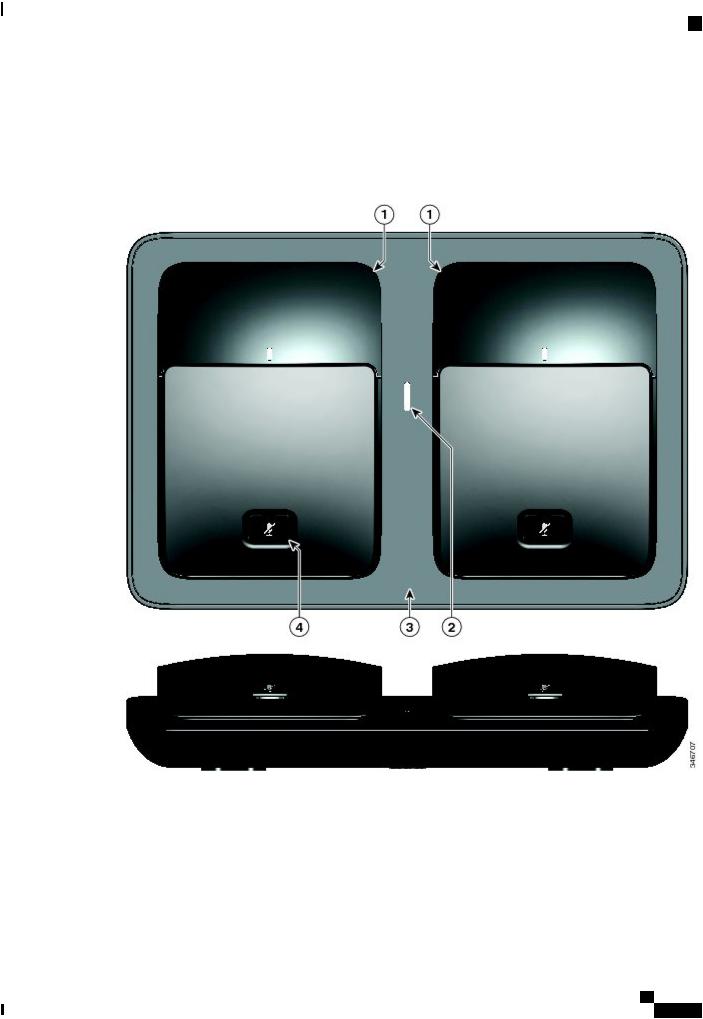
Features of your Cisco Unified IP Phone
Wireless extension microphone and charger
Wireless extension microphone and charger
The optional wireless extension microphone and charger kit unit contains two omni-directional wireless microphones, a charger unit and two country specific AC power clip adaptors for powering the charger unit. Connecting a microphone kit enhances the room coverage of the conference station.
Cisco Unified IP Phone 8831 User Guide for Cisco Unified Communications Manager 9.3
9
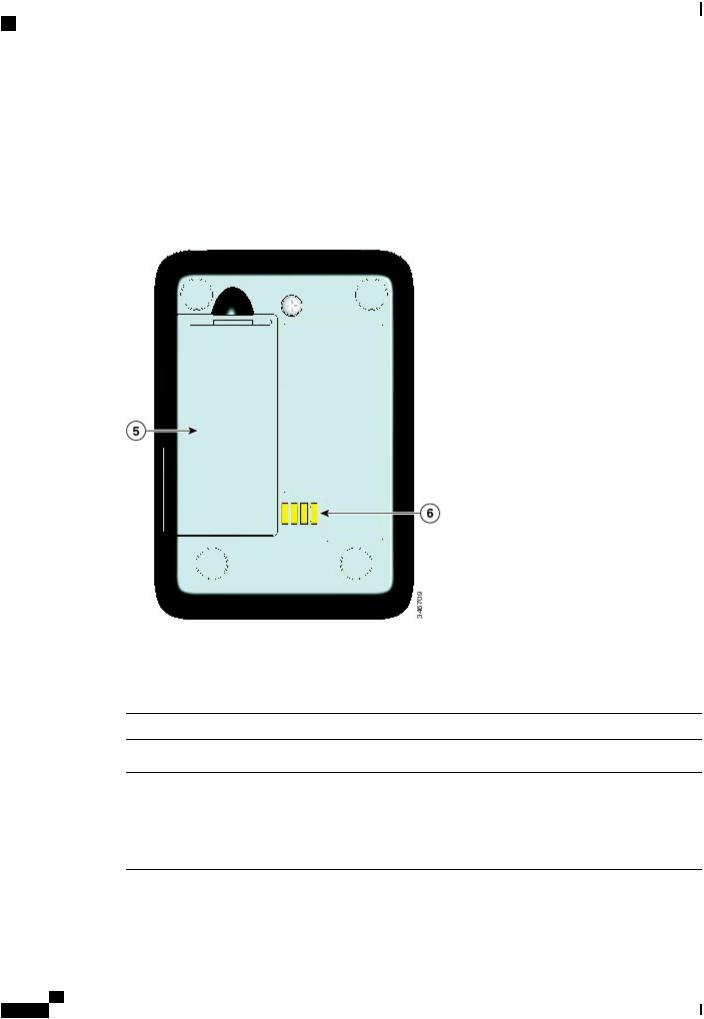
Features of your Cisco Unified IP Phone
Wireless extension microphone and charger
Table 3: Wireless microphone and charger buttons and features
Item |
Description |
1 |
Omni-directional wireless microphones |
2 |
LED charge status indicator |
3 |
Charger tray |
4 |
Mute button |
5 |
Battery compartment |
Cisco Unified IP Phone 8831 User Guide for Cisco Unified Communications Manager 9.3
10

Features of your Cisco Unified IP Phone
Wired extension microphone kit
Item |
Description |
6 |
Power level indicator. |
Note Please see the FCC ID approval number under the Battery Cover for CP-MIC-WRLS-S-US= Wireless Microphone. FCC ID: LDKMICWR0776
Note Please see the Canada IC approval number under the Battery Cover for the CP-MIC-WRLS-S-US= Wireless Microphone. IC: 2461B-MICWR0776
Wired extension microphone kit
The optional wired expansion microphone kit includes two wired omni-directional microphones. Connecting a microphone kit enhances the room coverage of the conference station. The sound base has two wired microphone ports and you can connect one or both wired microphones.
If the conference station is connected to another sound base in Linked Mode, the primary base station supports one or two wireless microphones, or it supports one wired microphone. The secondary unit supports only one wired microphone; a wireless microphone cannot be connected to a secondary Sound Base. You cannot mix microphonekits:ifyouplantoconnectamicrophonetobothsoundbases,theymustbothbewiredmicrophones.
Note Wired and wireless microphones cannot be used at the same time, and the wireless microphones have a higher priority. Attempting to connect a wired microphone to a conference station that has paired or connected channels results in a warning to the user that the wired microphone is disabled. To solve this problem, unpair any paired or connected wireless microphones before connecting a wired microphone.
Cisco Unified IP Phone 8831 User Guide for Cisco Unified Communications Manager 9.3
11
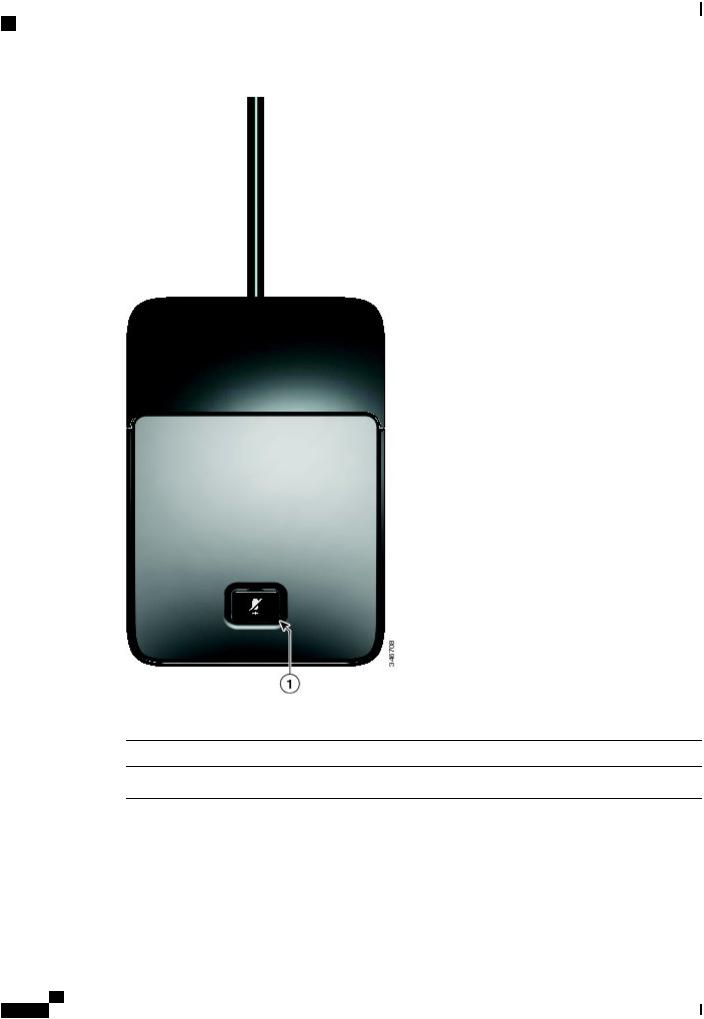
Features of your Cisco Unified IP Phone
Phone screen
Table 4: Wired microphone buttons |
|
Item |
Description |
1 |
Mute button. |
Phone screen
The LCD screen of the phone is located on the DCU. The idle or home screen displays information about the status of calls and features.
Cisco Unified IP Phone 8831 User Guide for Cisco Unified Communications Manager 9.3
12
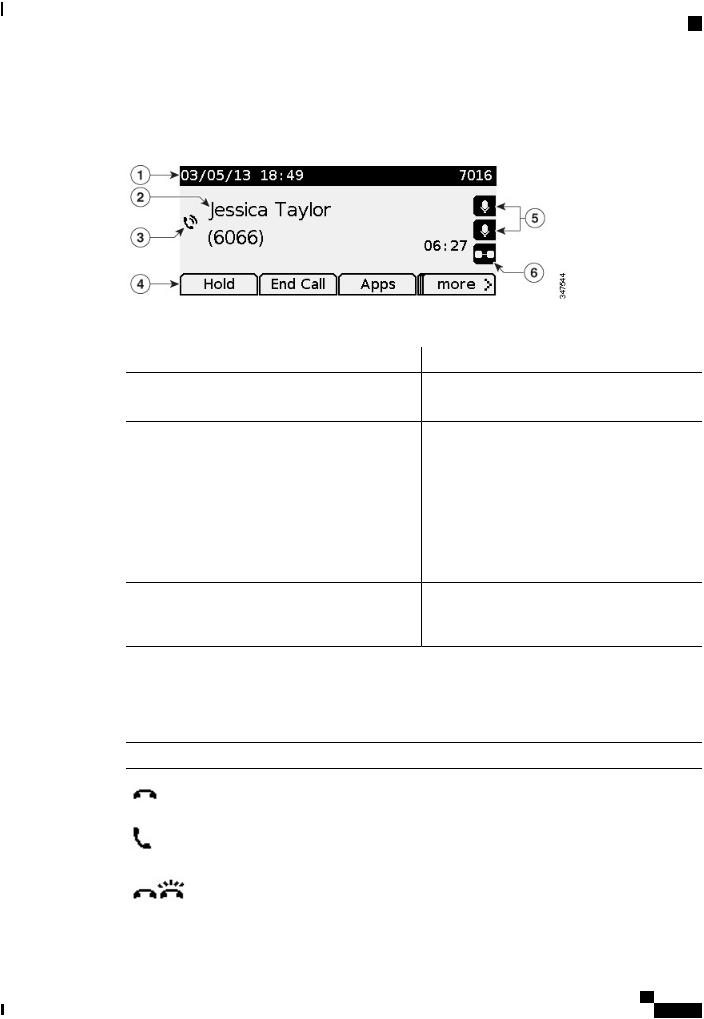
Features of your Cisco Unified IP Phone
Phone screen
If the conference station is in an offline state, the idle screen displays the message Phone is not registered and the Apps softkey remains available.
You can use the graphic and table below to identify the features and functions available on the screen.
Table 5: Phone screen layout.
|
Item |
Description |
1 |
Header |
Displays date, time, and current directory number. |
|
|
Displays menu name when applicable. |
2 |
Line details and other phone |
Displays line label, call details, and status messages |
|
information |
such as missed calls, message waiting, and line |
|
|
forwarding information. |
3 |
Call State icon |
Indicates the status of a call, such as ringing, hold, |
|
|
encrypted or connected call. |
4 |
Softkey labels |
Displays softkeys for currently available features or |
|
|
actions. |
5, 6 |
Feature icons |
These icons are displayed when an associated |
|
|
feature, such as extension microphones (5) or Link |
|
|
mode (6) is connected. |
Phone screen icons
Table 6: Phone screen icons
Icon |
Description |
|
On hook |
Off hook
Ringing in
Cisco Unified IP Phone 8831 User Guide for Cisco Unified Communications Manager 9.3
13

Features of your Cisco Unified IP Phone
Phone screen cleaning
Icon |
Description |
|
Connected |
Hold
Shared line
Microphone connected
Linked mode
Encrypted
Phone screen cleaning
Caution Use only a soft, dry cloth to wipe your conference station display screen. Do not use any liquids or powders on the phone, as they can contaminate phone components and cause failures.
Phone connections
Network and power are connected to the phone from the Sound Base. The mini-USB connection for the DCU, the wired microphone ports and the daisy chain port for the Linked Mode feature are also located on the base.
You can use the graphic and table below to identify connections and ports on the Sound Base.
Cisco Unified IP Phone 8831 User Guide for Cisco Unified Communications Manager 9.3
14
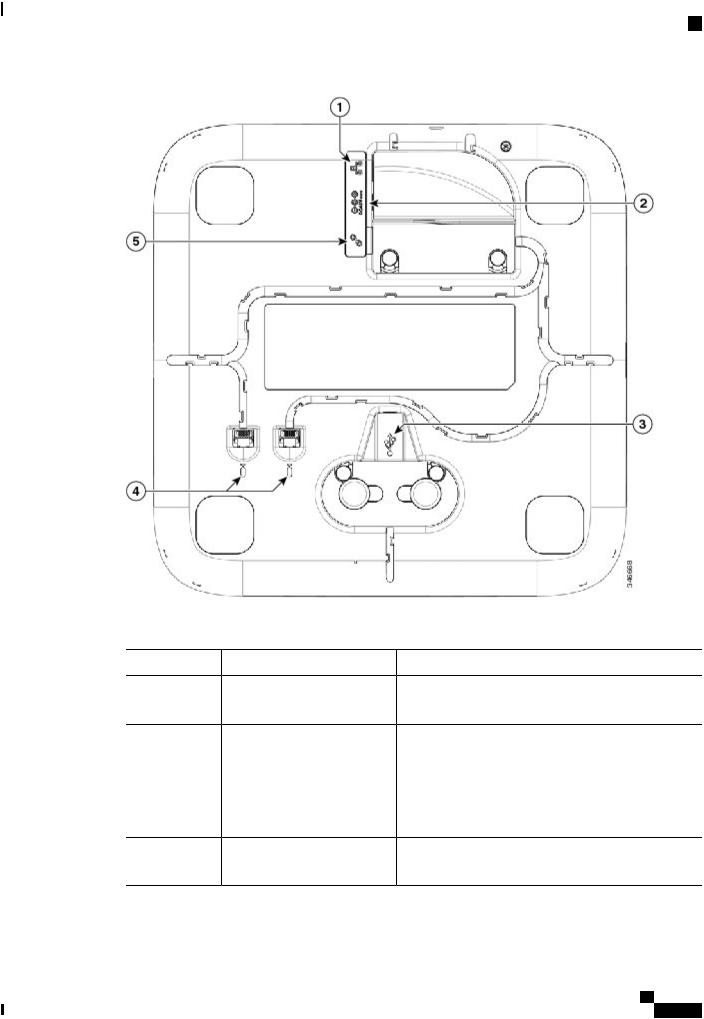
Features of your Cisco Unified IP Phone
Phone connections
Table 7: Sound Base connections and ports |
|
|
|
Item |
Description |
1 |
Network port |
Network port (10/100 SW) connection. IEEE 802.3af |
|
|
power enabled. |
2 |
Wall power |
Local power connection. |
3 |
Mini USB port |
Connects the base station to the DCU. |
4 |
Wired microphone ports |
Two RJ11 microphone ports. An optional wired |
|
|
microphone can be connected to each port. |
5 |
Linked Mode daisy chain port |
Supports the connection of two base stations in Linked |
|
|
Mode. |
Cisco Unified IP Phone 8831 User Guide for Cisco Unified Communications Manager 9.3
15
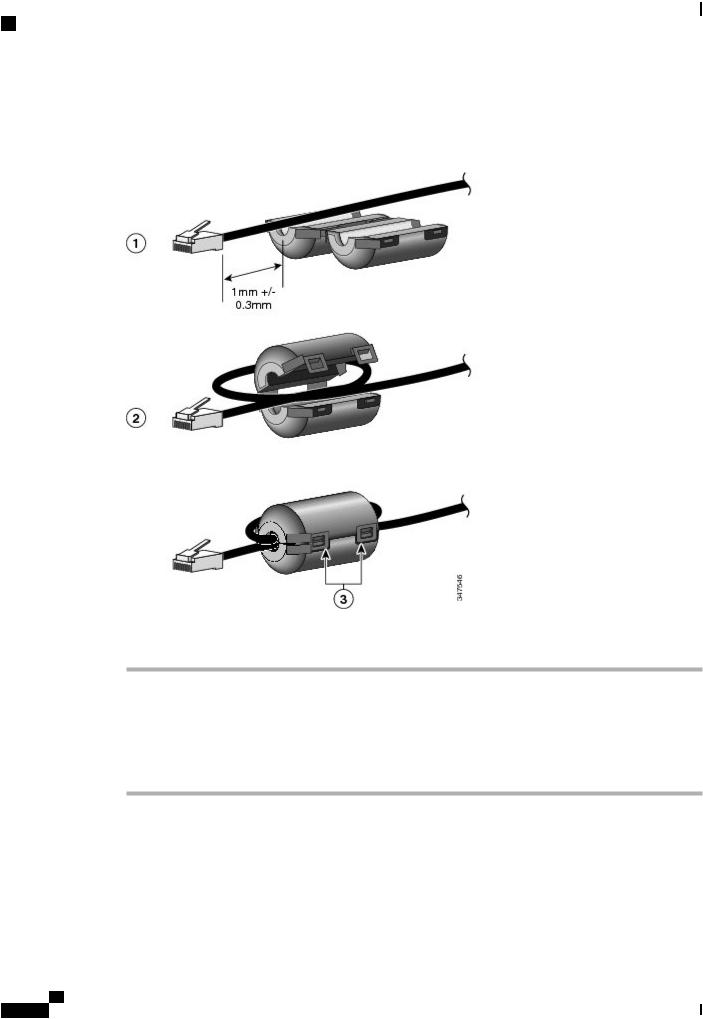
Features of your Cisco Unified IP Phone
Install ferrite bead
Install ferrite bead
The following images show how to install the ferrite bead on the network cable.
Procedure
Step 1 Align the ferrite bead with the head of the network cable and move the ferrite bead along the cable until there is a gap of 1.0 mm +/- 0.3 mm between the bead and the connector.
Step 2 Place the cable into the ferrite bead channel and loop the cable around the ferrite bead so that the cable exits the bottom of the bead.
Step 3 Hold the cable in the ferrite bead channel and close the ferrite bead. Both snaps on the ferrite bead should engage.
Cisco Unified IP Phone 8831 User Guide for Cisco Unified Communications Manager 9.3
16
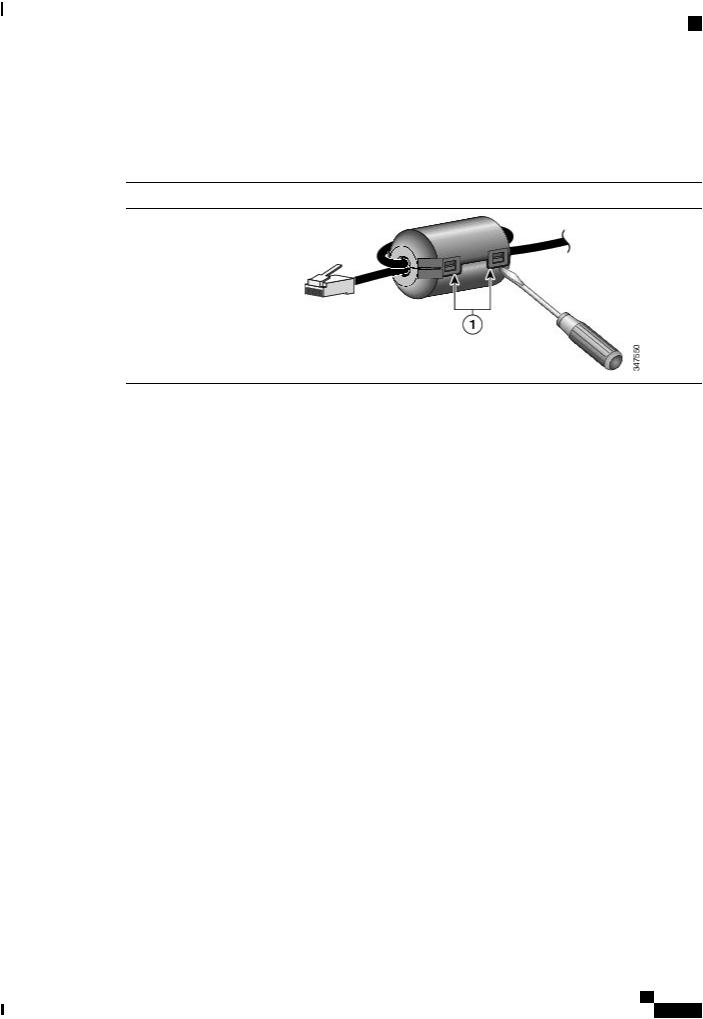
Features of your Cisco Unified IP Phone
General IP Phone information
Remove ferrite bead
Procedure
Command or Action |
Purpose |
Step 1 Disengage the snap |
|
enclosure with a small |
|
screwdriver as shown in |
|
the figure. |
|
General IP Phone information
Power-saving mode
Your conference station supports the Cisco EnergyWise (EW) program. Your system administrator sets up sleep (power down) and wake (power up) times for your conference station to save energy. In the sleep state, the LED for the sound base Mute button becomes solid gray, and the DCU powers off.
Ten minutes before the scheduled sleep time, you receive a message that the conference station will power down at a specific time. If the power-saving mode is enabled by your system administrator, you hear your ringtone play. The ringtone plays according to the following schedule:
•At 10 minutes before power down, the ringtone plays four times
•At 7 minutes before power down, the ringtone plays four times
•At 4 minutes before power down, the ringtone plays four times
•At 30 seconds before power down, the ringtone plays 15 times or until the phone powers down
If your conference station is inactive (idle) at the sleep time, it powers down. If your conference station is active (for example, on a call), it waits until it has been inactive for a period of time before removing power.
After the conference station goes to sleep, press the Mute button on the sound base to wake the conference station up. You cannot wake the conference station using the DCU. After it is inactive for a period of time, the conference station goes back to sleep. At the set wake time, the conference station powers up.
Wake and sleep times are also linked to the configured days that you normally work. If your requirements change (for example, your work hours or work days change), contact your system administrator to have your conference station reconfigured.
For more information about EnergyWise and your conference station, contact your system administrator.
Cisco Unified IP Phone 8831 User Guide for Cisco Unified Communications Manager 9.3
17

Features of your Cisco Unified IP Phone
Feature availability
Feature availability
Depending on the conference station system configuration, features included in this guide might not be available to you or might work differently on the conference station. Contact your support desk or system administrator for information about feature operation or availability.
Cisco Unified IP Phone 8831 User Guide for Cisco Unified Communications Manager 9.3
18

C H A P T E R 3
Applications
• Services, page 19
• Call History, page 19
• Preferences, page 22
• Linked Mode, page 23
• IP Phone Information, page 24
• Administrator Settings, page 25
Services
Conference Station services can include special telephony features, network data, and web-based information. The services available for your phone depend on the system configuration and the services you are subscribed to. For more information, see your system administrator.
Access Services
Procedure
Step 1 Press Apps.
Step 2 Use the navigation bar and Select button to scroll and select the service you want to access.
Step 3 Press the Select softkey, or press Exit to return to the Applications screen.
Call History
Call History allows you to view information about calls made to and from the conference station. A call state icon is displayed to indicate the type of call:
Cisco Unified IP Phone 8831 User Guide for Cisco Unified Communications Manager 9.3
19

Applications
View call history
•Received
•Placed
•Missed
A maximum of 50 records are stored for each history type.
The caller ID is displayed with the call icon. If the caller ID is unavailable, then the phone number is displayed. If the phone number is unavailable, then the message Unknown is displayed. All Call History items are integrated into one list and are ordered by time (latest to oldest).
You can dial a number directly from the Call History list.
If set up by your administrator, the received and placed calls from shared lines are logged in the Call History. To view all the call history logs, open the Call History screen.
View call history
Procedure
Step 1 Press Apps.
Step 2 Use the navigation bar and Select button to scroll and select Call History.
View call record details
Step 1
Step 2
Step 3
Step 4
Procedure
Press Apps.
Use the navigation bar and Select button to scroll and select Call History.
Select a call record and press Details.
If the Details softkey is not visible on the screen, press More first.
Press  to return to the Call History list.
to return to the Call History list.
Cisco Unified IP Phone 8831 User Guide for Cisco Unified Communications Manager 9.3
20

Applications
Dial from Call History
Dial from Call History
Procedure
Step 1 Press Apps.
Step 2 Use the 2-way navigation bar and Select button to scroll and select Call History.
Step 3 From the Call History list, select the call you want to dial and press Call.
Edit phone number
Procedure
Step 1 Press Apps.
Step 2 Use the navigation bar and Select button to scroll and select Call History.
Step 3 Select the call you want to edit.
Step 4 Press Edit Dial
Step 5 Press >> to move the cursor to the right and press << to move the cursor to the left.
•Pressing the Up arrow of the 2-way rocker sends the cursor to ahead of the left-most character.
•Pressing the Down arrow of the 2-way rocker sends the cursor to ahead of the right-most character.
Step 6
Step 7
Step 8
Press  to delete numbers.
to delete numbers.
Press Dial to dial the edited number. Press  to return to the Call History list.
to return to the Call History list.
Clear call history
Procedure
Step 1 Press Apps.
Step 2 Use the navigation bar and Select button to scroll and select Call History.
Step 3 Press Clear.
Step 4 Press Delete to delete the Call History list, or press Cancel to go back to the Call History screen.
Cisco Unified IP Phone 8831 User Guide for Cisco Unified Communications Manager 9.3
21
